struck dumb by enlightenment: the notable horror in 'Last Voyage of the Demeter'
André Øvredal's Dracula-sourced film drips with the blood of man's divorce from myth.
“If we are defeated, then there is no god.”1
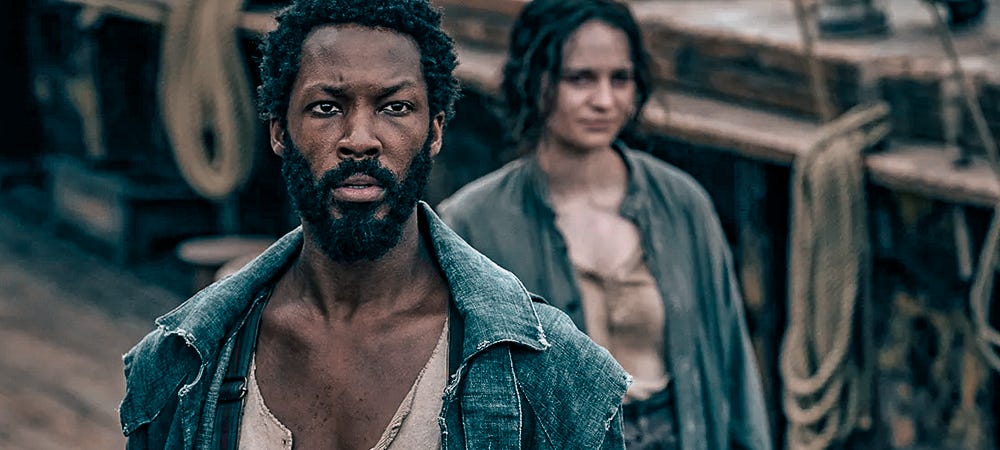
[Contains spoilers for Last Voyage of the Demeter, the 2023 film based on Chapter 7 of Bram Stoker's Dracula. It recounts the doomed voyage of the ship bearing the legendary Count from Transylvania to England.]Moral psychologist C. Fred Alford observed that ‘the vampire has replaced Satan as the leading figure of evil’ in popular culture.2 It makes sense then that horror story heroes so frequently raise the cross, which crushed Satan, against this legendary monster. In many tales, including Bram Stoker’s 1897 proto-myth, crucifixes, holy water, and the host are used to repel vampires and those turned by vampires with varying degrees of success.
However, this year’s Last Voyage of the Demeter, the latest Dracula-sourced horror film, follows a recent trend in vampire stories: it blatantly portrays the cross as useless against the film’s rendition of the archetypal bloodsucker. I was shocked on first viewing, but this plot choice—a significant diversion from the source material—isn’t breaking new ground. In 1998’s Blade, the titular character makes no bones about crucifixes and holy water being ineffective against his night-bound enemies. “Forget what you’ve seen in the movies,” he says.
Words alone don’t have the visceral impact of the grandson of the Demeter’s captain, a young boy named Toby (Woody Norman), clutching his rosary as Dracula closes in. As the monster bites him, the camera shifts to the rosary as it slips uselessly from the boy’s limp fingers.
Says The Bloomsbury Companion to Religion and Film:
…as cinematic evil has become more ambiguous and less anchored to fixed religious coordinates and moral absolutes, the vampire has also become increasingly ambiguous as more and more films augment the humanity of the vampire while attempting to retain his or her destructive power. Likewise, conventional means for stopping supernatural evil (holding forth a crucifix, retreating into a church building, etc.) rarely work anymore at the movies.3
If art imitates life, today’s popular entertainment reflects a cultural decline in religious belief. If the shadow of the cross is shrinking in the West, so should its sway over metaphysical and mythic darkness in our entertainment. This makes it even more ironic that horror maintains its fascination with the supernatural and devotedly wrestles with monstrosity via religious aesthetics.
Throughout the 20th century, horror film has relied more or less consistently on explicitly religious symbols, allusions, and themes. As we move into the 21st century, there are no indications that this reliance is diminishing; in fact, there is every reason to believe that it may be picking up new steam. And yet despite the resilience of the religious on screen, the form that the religious takes has been greatly altered by the processes and patterns of late modernity…4
I won’t get carried away parsing the cross’s lack of efficacy in Last Voyage of the Demeter, which reflects these “processes and patterns”—in fact, I’ve written something tangentially related elsewhere. But I do want to talk about the film’s protagonist, a doctor named Clemens, who is the vessel for the film’s big argument.
Clemens (Corey Hawkins) does not exist in the sixteen-page chapter of Dracula from which this two-hour movie is adapted. He is an outsider among the crew of the Demeter: a black man among white Europeans, a doctor and astronomer educated at Cambridge, among a group of uneducated sailors.
However, the most significant difference between Clemens and everyone else aboard the ship is one of intellectual belief. The sailors assemble along a spectrum of superstition, myth, and religion. They believe in God, Poseidon, hell, and demons—and that a woman on board means bad luck. Clemens believes in nature and science. When the ship’s livestock and the first crew member turn up dead, he argues that there is an understandable, natural explanation for it all. The crew, on the other hand, quickly concludes that someone or something evil is on board the ship and intends to drag them all to watery graves.
This back-and-forth between Clemens’ new-era views and the old-era beliefs of the Demeter’s regulars continues throughout the film.
“The skies are angry,” the crewman Olgaren observes as he and Clemens are up in the rigging.
“The skies feel nothing, my friend,” Clemens says. “It’s precipitation and air pressure as knowable as the workings of this ship.”
Later, after Dracula attacks Olgaren and turns him into his thrall, the other sailors liken Olgaren’s behavior to one possessed by demons. But Clemens insists, “Oh no, not [possession] in the way you mean. It’s a poison or an infection.”
“I don’t believe in superstitions. I believe in science and nature,” Clemens later emphasizes. He adds jokingly, “And [I believe] in Saint Nicholas, since Joseph wouldn’t give me food otherwise.”
Perhaps in parallel with the ineffectual cross is the fate of the ship’s most openly Christian character, the cook Joseph (Jon Jon Briones). He corrects the men when they swear, take the Lord’s name in vain, or make jokes about brothels at the dinner table. The liberal Scripture-quoter assumes the bloody haunting of the Demeter is nothing less than an act of God. “It is a punishment brought down for our sins,” he says. “Petrovsky a criminal. Olgaren, gypsy heathen…a whoremonger, a lecher… God’s anger has come upon this vessel like Jonah.”
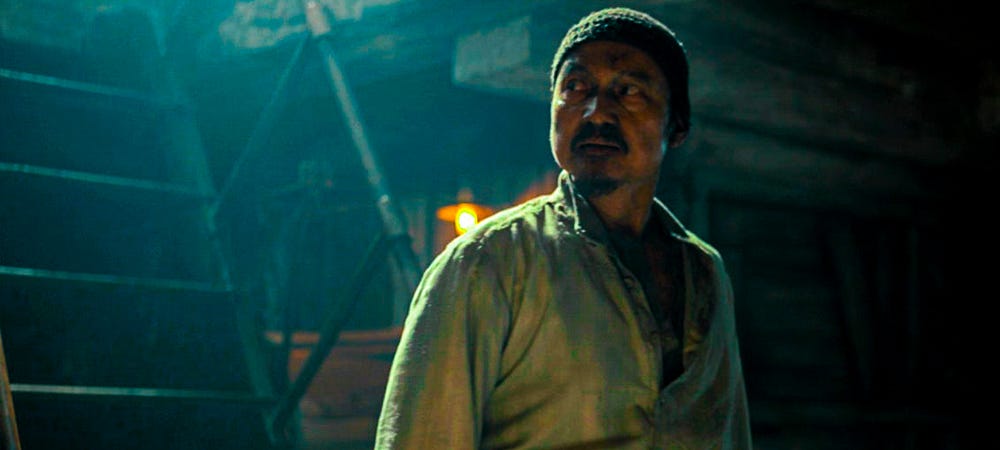
Joseph is the only one smart enough to abandon ship, taking one of the lifeboats in the middle of the night and setting off into the darkness.
Dracula can fly (of course) and tracks him down, taunting the cook by whispering back to him the Scriptures he’s been clinging to. “I cried and you heard my voice.” Joseph supplicates the heavens, but Dracula tears into his throat, silencing his prayers.
Filmmaker David Cronenberg calls horror ‘the genre of confrontation.’ I’m no horror connoisseur, but that very reason is why the plight of the vampire in popular fiction interests me. The vampire “willfully embraces evil, inverts normative patterns of valuation, and violates established institutions of family, religion, science, and law… At the same time, the vampire offers his victims a new birth—a new and immortal patriarchy in which he not only is the husband of numerous brides but father of countless ‘children of the night.’”5 This gross living darkness is cast opposite light, self-sacrifice, and virtue.
Vampires pose a deep metaphysical puzzle about how to create new structures for meaning and value within the time scale of godless eternity... some seek to create new ethical norms in a vacuum where traditional science and religion have lost their grip.6
Last Voyage of the Demeter is by no means a great film—it’s much too long, and the monster’s monstrousness is far too obvious—but it casts in stark terms a clash of commitments, aptly demonstrating horror’s affinity for confrontation. On the one hand, there is a commitment to science and naturalism. On the other, there is superstition and religious belief. And the film leaves no question about which worldview is better.
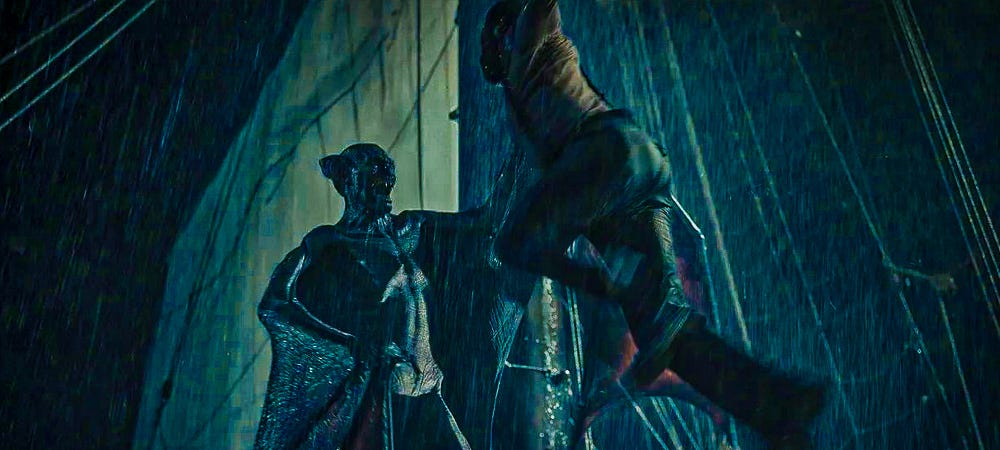
Clemens, the naturalist, is the only person to survive the bloodbath and wreck of the Demeter; he washes up on England’s shores. Dracula’s survival is foregone—he’s out prowling Whitby for fresh blood.7 In Clemens’ voiceover during the moody and chilling denouement (perhaps the best segment of the film), he makes plain his intention to hunt the monster. But Clemens’ gritty confidence in his own ability to find and stamp out what is to him an explainable freak of nature does not measure up. The audience knows, I know, that Dracula is a seductive mystery, something beyond the capabilities of a scientist or medical professional to confront without the help of religion, enchantment, or what one might call superstition.
Earlier in the film, the crew begins drifting toward acceptance of Clemens’ conjectures about the ill that has befallen their voyage. But one sailor holds out, blurting, “Have you all been struck dumb!?” He refuses to believe that a Cambridge-educated doctor has any better explanation for why all the animals aboard the ship had their throats ripped out in a single night or why a barely-alive woman was found in a box of dirt below-deck. In the source material,8 the highly educated doctor-lawyer-scientist Abraham van Helsing turns to religious symbols and folk superstitions to wage war against Dracula.
A striking contrast between Dracula and Demeter, indeed.
When the monster’s presence aboard the ship first becomes apparent, the captain (Liam Cunningham) writes in his log, “We must put our trust in God and go forward.”
After his grandson Toby’s rosary is proven ineffective against the monster, and the boy is rendered catatonic and undead, Captain Elliot puts his faith in Clemens. He tells Toby, “Everything will be fine, my boy. Mr. Clemens will take care of us… God seems to have deserted us, and we are drifting to some terrible doom.”
But even Clemens is at his wit’s end. He can conjure no remedy for the boy. And once the crew has pitched Toby’s burning body into the sea, Elliot gives up all hope. “We are no longer plotting our own course. The devil below does, and we all know where he plans to deliver us,” he tells the doctor. “To hell, Mr. Clemens. Each of us, one by one.”
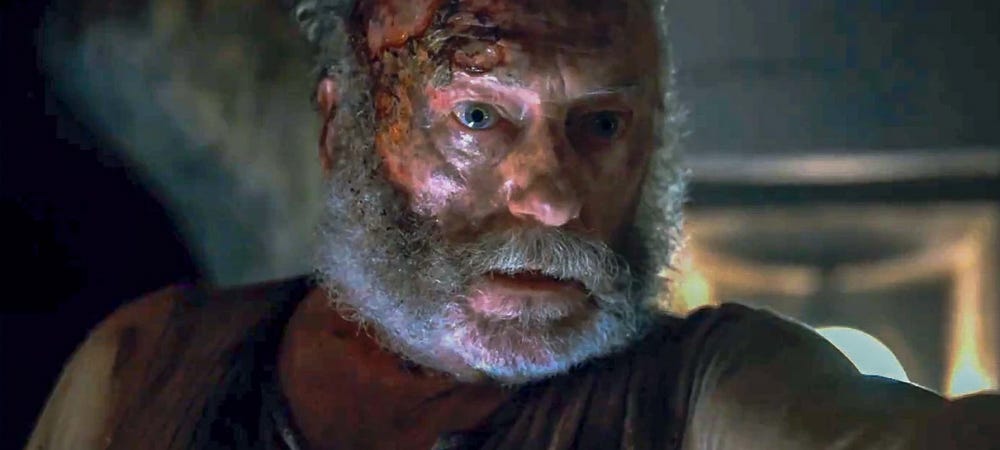
Elliot’s journey, from faith in God to faith in a worldly wiseman to faithlessness and despair, mirrors societal shifts from the pre-Enlightenment era till now. Rooted belief in the supernatural gave way to an age of reason and man’s faith in his ability to figure out the world. And now, in our current era, we see the disillusionment of man disappointed in fellow man, a disenchanted view toward the material world, and the exorcism of the supernatural from public discourse.
Here and now, we are giving way to faithlessness. Worldly wisdom has failed us.
We’ve been struck dumb by enlightenment.
By rendering Toby’s rosary an ineffective talisman, Last Voyage of the Demeter torpedoes its entire framework. The inversion of iconography yanks the carpet from under the Dracula proto-myth, becoming a discrete image of the great divorce of man from myth—a divorce the film wants to imbue with virtue. After all, if mythic and religious means aren’t needed to combat the monster, the monster can’t possibly be beyond nature. The excision of enchantment is complete, and enlightenment has drawn the curtain on the world’s mysteries. All our problems are here and now and can be appealed to nothing higher than human intellect.
That’s what Clemens intends to do. He is on the side of “progress,” which means knowledge about all that he can perceive. Knowledge of good and evil, for good or ill. He ‘needs this world to make sense,’ but that’s because this world is all he has.
In his final stand against the monster, Captain Elliot clings to his ship’s helm with one hand and brandishes his dead grandson’s rosary with the other. “I renounce you, devil!” he cries as Dracula swoops towards him. But the monster swats the rosary aside and impales Elliot on the helm, his arms spread wide as if crucified.
asides + signal boosts
It’s “spooky season” as they say, and if you liked this religion and horror essay, you might also like something else I wrote along similar lines. I’ve got a piece in Lorehaven titled How The Crucifix Shows Christ’s Salvation in Dark Fantastical Stories. It takes a different tack and is more directly about Christian symbology in fantasy, horror, and speculative fiction tales. Yes, Last Voyage of the Demeter inspired that one too.
Metric, my favorite back-burner band is at it again, releasing Formentera II, the sequel to 2022’s brilliant Formentera. Curiously, the nine songs on this album were “mostly written and recorded before the nine songs that are on the first album.” Time is a construct. Give this a listen!
Instead of talking about things I’ve watched lately (because I haven’t watched much), I want to highlight three productions that I’m really looking forward to: Apple TV+’s Killers of the Flower Moon, Netflix’s soon-to-be-released WWII-era series All the Light We Cannot See, and next year’s fun-looking writer/spy film Argylle. Do you plan on checking out any of these? If you do, let me know what you think! Maybe we’ll talk about them in the future.
Professor Abraham Van Helsing (Laurence Olivier) in John Badham’s 1979 Dracula film adaptation.
What Evil Means to Us, by C. Fred Alford (1997)
The Bloomsbury Companion to Religion and Film, edited by William L. Blizek
Bryan Stone, “The Sanctification of Fear: Images of the Religious in Horror Films,” Journal of Religion & Film, Vol. 5, Issue 2
The Bloomsbury Companion to Religion and Film, edited by William L. Blizek
The Naked and the Undead: Evil and the Appeal of Horror, by Cynthia Freeland
It feels wrong to call the monster of this film “Dracula,” because it has none of the personality of Stoker’s character. It hardly even speaks.
There isn’t a sequel planned for Last Voyage, but if there were, it wouldn’t work. The storyworld has been re-written in such a way that the passion and religious fervor with which Dr. Van Helsing and his companions attend to their war against Dracula would make little sense.




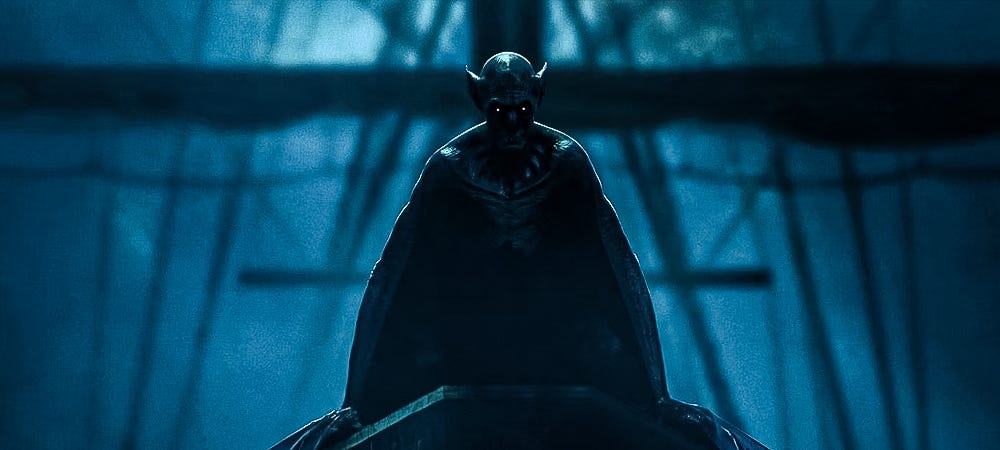
It may be because I’m on a Buffyverse kick at the moment, but I do wonder if the vampire is only now a replacement for Satan within certain genres. Within the “let’s target teen girls” genre, I would argue that vampires are the latest to be successfully reinvented as at least morally grey if not good guys.
1) We begin with the re-ensouled Angel who is deeply repentant of all he did as a vampire before being re-ensouled. Still a vampire (spoiler!) he will lose his soul should he experience true happiness and revert to his demonic ways.
2) Spike (still Buff) seeks out being re-ensouled to win the heart of the woman he loves.
3) Mina Harker in the League of Extraordinary Gentlemen is definitely one of the good guys despite having being turned previously.
⏳Moving rapidly forward (there may be other illustrations)
4) Twilight - need I say more?
5) The Vampire Diaries - at every point there is at least one vampire who is a “hero”. The rest of the vampires are morally grey. If they look like a villain we’re probably about to discover a tragic backstory to make them morally grey.
6) The House of Night series - the vampyres are the heroes but they’re not the vampires of legend. These are a wicca-vampire hybrid reinvented for the 21st century teen.
I keep considering writing something on this but have no problem with others taking the idea and running with it either.